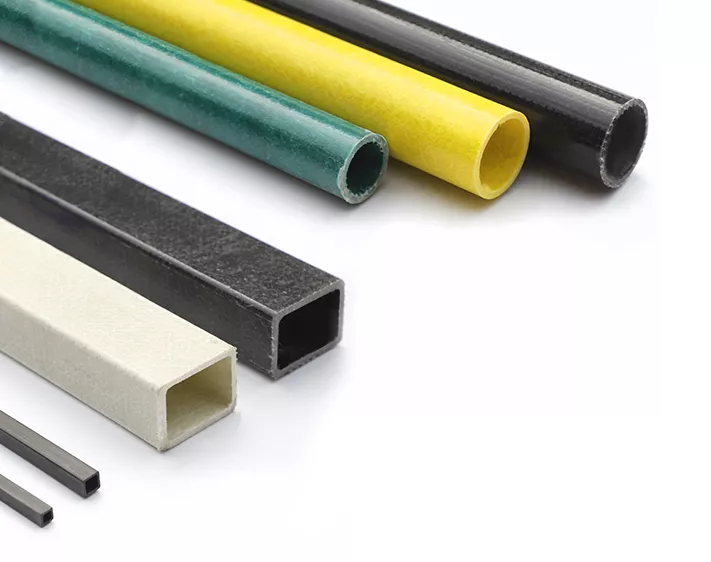FRP Round Tube vs FRP Square Tube: What’s the Difference
Consider choosing FRP circular or FRP square pipes, usually based on differences in structure and stress, impact resistance, and installation environment
Fiberglass Reinforced Plastic (FRP) is widely used in modern construction, industry, and transportation due to its high strength, lightweight, and corrosion resistance. Among them, FRP round tubes and FRP square tubes are two common structural profiles, often used in railings, supports, frames, and handrails. Today, let's discuss the characteristics, differences, and common applications of these two types of FRP profiles.
1. What is an FRP Pipe?
FRP (Fiberglass Reinforced Plastic) is a high-performance composite material made of fiberglass and a resin matrix. The pultrusion process is used to manufacture FRP pipes, making them lightweight yet capable of withstanding high tensile and bending loads. They are also corrosion-resistant, electrically insulating, and rust-free, making them ideal for environments where traditional metal materials fail.
Key Features of FRP Pipes:
Corrosion Resistance – Suitable for humid and chemical environments, resistant to rust and corrosion.
High Strength & Lightweight – More than 30% lighter than steel while maintaining comparable strength.
Electrical Insulation – Non-conductive and highly safe for electrical applications.
Weather Resistance – UV-resistant and suitable for outdoor environments.
Easy Installation & Maintenance – Can be cut, drilled, and easily installed, offering a long service life.
2. FRP Round Tube vs. FRP Square Tube: What’s the Difference?
2.1 Structural & Load-Bearing Differences
| Feature | FRP Round Tube | FRP Square Tube |
|---|---|---|
| Load Distribution | Uniform stress distribution, strong torsional resistance | More stable structure, strong bending resistance |
| Impact Resistance | Better resistance to external impacts | More prone to deformation after impact |
| Rigidity | Lower rigidity, suitable for lightweight structures | Higher rigidity, capable of carrying greater loads |
| Installation Difficulty | Requires special fasteners | Easy to connect and assemble |
| Material Utilization | Even structure, high material efficiency | Slightly lower material utilization |
2.2 Best Applications for Each Type
FRP Round Tube (FRP Circular Pipe)
Characteristics:
- Even stress distribution and strong torsional resistance, ideal for axial load-bearing structures.
- Good aerodynamics, reducing air resistance or liquid flow resistance.
- Suitable for high-strength, lightweight, and flexible installation applications.
Common Applications:
Railings & Handrails (e.g., balconies, bridges, stair railings).
Antenna Supports (electromagnetic transparency avoids signal interference).
Industrial Piping (for corrosive fluid or gas transport).
Sports Equipment (e.g., pole vault poles, paddles, fishing rods).
FRP Square Tube (FRP Rectangular Pipe)
Characteristics:
- Stronger bending resistance, ideal for lateral load-bearing structures.
- Easier to install and connect, suitable for framework structures.
- Ideal for applications requiring stability and high rigidity.
Common Applications:
Structural Frames (e.g., cable trays, equipment supports, platform frames).
Industrial Walkways & Platforms (corrosion-resistant and heat-resistant).
Building Support Structures (e.g., solar panel supports, greenhouse frames).
Bridge Reinforcement (used as a reinforcement material).
3. How to Choose the Right FRP Pipe?
When selecting the right FRP pipe for engineering applications, consider the following factors:
Is uniform load distribution required?
- Yes → Choose FRP Round Tube (for handrails, antenna supports, etc.).
- No → Choose FRP Square Tube (for frames, supports, etc.).
Does the structure require high bending resistance?
- Yes → Choose FRP Square Tube (stronger bending resistance, suitable for platforms and supports).
Does the application involve fluid transport?
- Yes → Choose FRP Round Tube (for corrosive gas or liquid pipelines).
Does the installation require easy assembly and connections?
- Yes → Choose FRP Square Tube (easier to fasten and join).
4. Maintenance and Usage Tips for FRP Pipes
Although FRP has excellent corrosion resistance and durability, proper maintenance can extend its service life:
Regular Cleaning – Use clean water or mild detergent to wipe surfaces and maintain appearance.
Avoid Heavy Impact – While FRP has good impact resistance, excessive force can cause structural damage.
Proper Fastening – Ensure fasteners are secure during installation to prevent loosening.
Avoid High Temperatures – FRP has heat resistance limits, and prolonged exposure to extreme heat may weaken the resin.
FRP Round and Square Tubes are essential components in fiberglass composite materials, playing a crucial role in modern engineering. Whether in construction, industrial applications, or daily infrastructure, they offer superior performance, durability, and efficiency.
If you’re looking for a lightweight, high-strength, corrosion-resistant, and long-lasting alternative to traditional metal materials, FRP pipes are an excellent choice!
wo supply different FRP pipes products ,you may get morkane info from https://www.hxfrp.net/products/fiberglass-tubes-round
We hope this article helps you better understand the applications and selection of FRP pipes, making your engineering projects more efficient, safer, and more durable!

